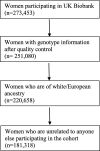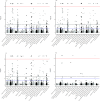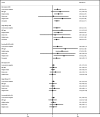Identifying potential causal effects of age at menarche: a Mendelian randomization phenome-wide association study
- PMID: 32200763
- PMCID: PMC7087394
- DOI: 10.1186/s12916-020-01515-y
Identifying potential causal effects of age at menarche: a Mendelian randomization phenome-wide association study
Abstract
Background: Age at menarche has been associated with various health outcomes. We aimed to identify potential causal effects of age at menarche on health-related traits in a hypothesis-free manner.
Methods: We conducted a Mendelian randomization phenome-wide association study (MR-pheWAS) of age at menarche with 17,893 health-related traits in UK Biobank (n = 181,318) using PHESANT. The exposure of interest was the genetic risk score for age at menarche. We conducted a second MR-pheWAS after excluding SNPs associated with BMI from the genetic risk score, to examine whether results might be due to the genetic overlap between age at menarche and BMI. We followed up a subset of health-related traits to investigate MR assumptions and seek replication in independent study populations.
Results: Of the 17,893 tests performed in our MR-pheWAS, we identified 619 associations with the genetic risk score for age at menarche at a 5% false discovery rate threshold, of which 295 were below a Bonferroni-corrected P value threshold. These included potential effects of younger age at menarche on lower lung function, higher heel bone-mineral density, greater burden of psychosocial/mental health problems, younger age at first birth, higher risk of childhood sexual abuse, poorer cardiometabolic health, and lower physical activity. After exclusion of variants associated with BMI, the genetic risk score for age at menarche was related to 37 traits at a 5% false discovery rate, of which 29 were below a Bonferroni-corrected P value threshold. We attempted to replicate findings for bone-mineral density, lung function, neuroticism, and childhood sexual abuse using 5 independent cohorts/consortia. While estimates for lung function, higher bone-mineral density, neuroticism, and childhood sexual abuse in replication cohorts were consistent with UK Biobank estimates, confidence intervals were wide and often included the null.
Conclusions: The genetic risk score for age at menarche was related to a broad range of health-related traits. Follow-up analyses indicated imprecise evidence of an effect of younger age at menarche on greater bone-mineral density, lower lung function, higher neuroticism score, and greater risk of childhood sexual abuse in the smaller replication samples available; hence, these findings need further exploration when larger independent samples become available.
Keywords: MR-pheWAS; Menarche; Mendelian randomization.
Conflict of interest statement
DAL receives (or has received in the last 10 years) research support from national and international government and charitable bodies, Roche Diagnostics, and Medtronic for research unrelated to the current work. The other authors declare that they have no competing interests.
Figures









References
-
- Luijken J, van der Schouw YT, Mensink D, Onland-Moret NC. Association between age at menarche and cardiovascular disease: a systematic review on risk and potential mechanisms. Maturitas. 2017;104:96–116. - PubMed
-
- Miller LJ, Girgis C, Gupta R. Depression and related disorders during the female reproductive cycle. Womens Health (Lond) 2009;5:577–587. - PubMed
Publication types
MeSH terms
Grants and funding
- MC_PC_19009/MRC_/Medical Research Council/United Kingdom
- NIEHS ZO1 ES49019/ES/NIEHS NIH HHS/United States
- BHF_/British Heart Foundation/United Kingdom
- R01 HL105756/HL/NHLBI NIH HHS/United States
- R01 DK10324/NH/NIH HHS/United States
- MC_UU_00011/6/MRC_/Medical Research Council/United Kingdom
- WT202849/WT_/Wellcome Trust/United Kingdom
- WT_/Wellcome Trust/United Kingdom
- MC_PC_17228/MRC_/Medical Research Council/United Kingdom
- MC_QA137853/MRC_/Medical Research Council/United Kingdom
- MR/N011317/1/MRC_/Medical Research Council/United Kingdom
- R01HL105756/HL/NHLBI NIH HHS/United States
- Department of Health [UK]/International
- 102215/2/13/2/WT_/Wellcome Trust/United Kingdom
- HEALTH-F2-2008-201865-GEFOS/European Commission/International
- G0902313/MRC_/Medical Research Council/United Kingdom
- HHSN273201800005I/ES/NIEHS NIH HHS/United States
- Z01 ES049019/ImNIH/Intramural NIH HHS/United States
- MR/M009351/1/MRC_/Medical Research Council/United Kingdom
LinkOut - more resources
Full Text Sources

